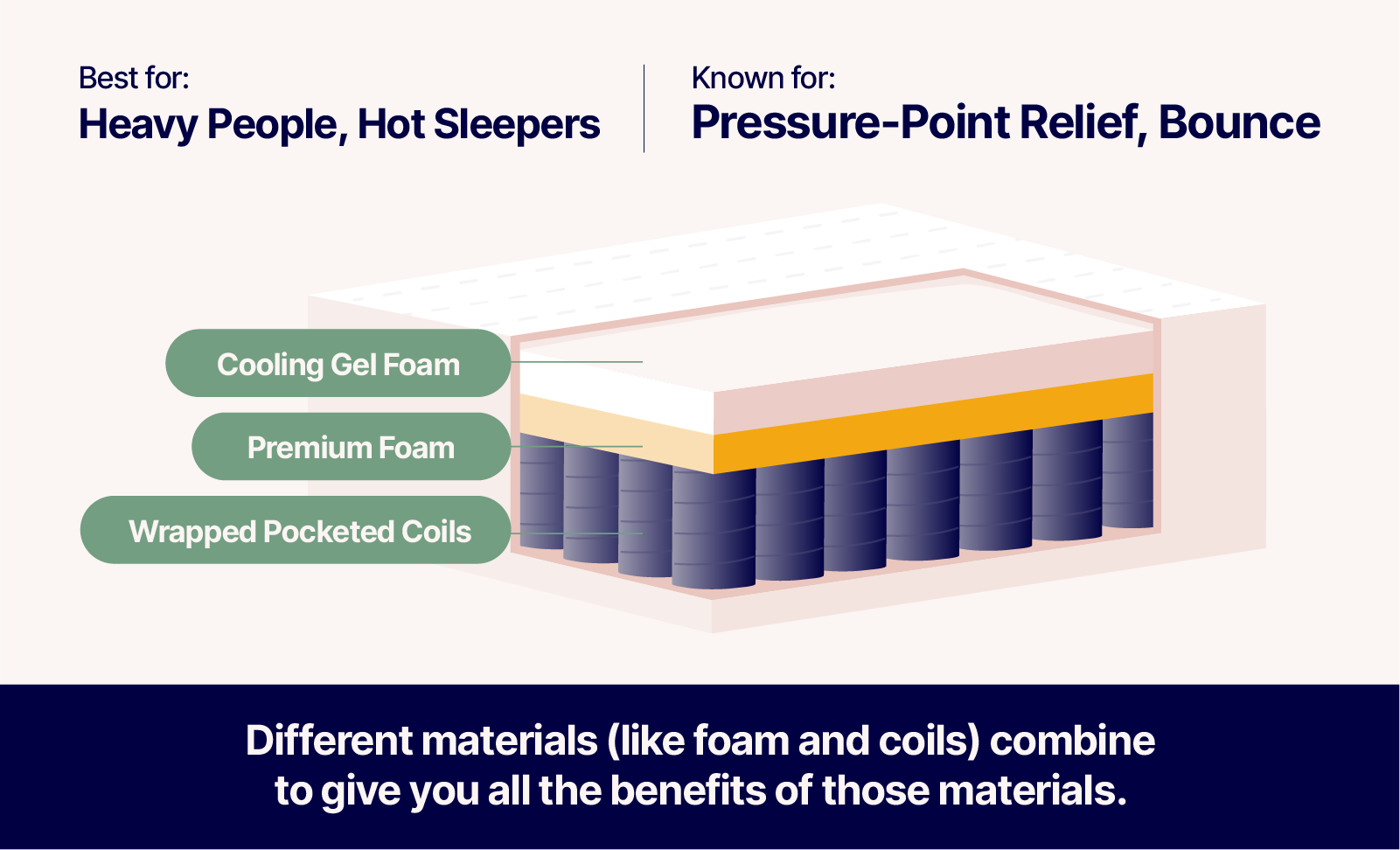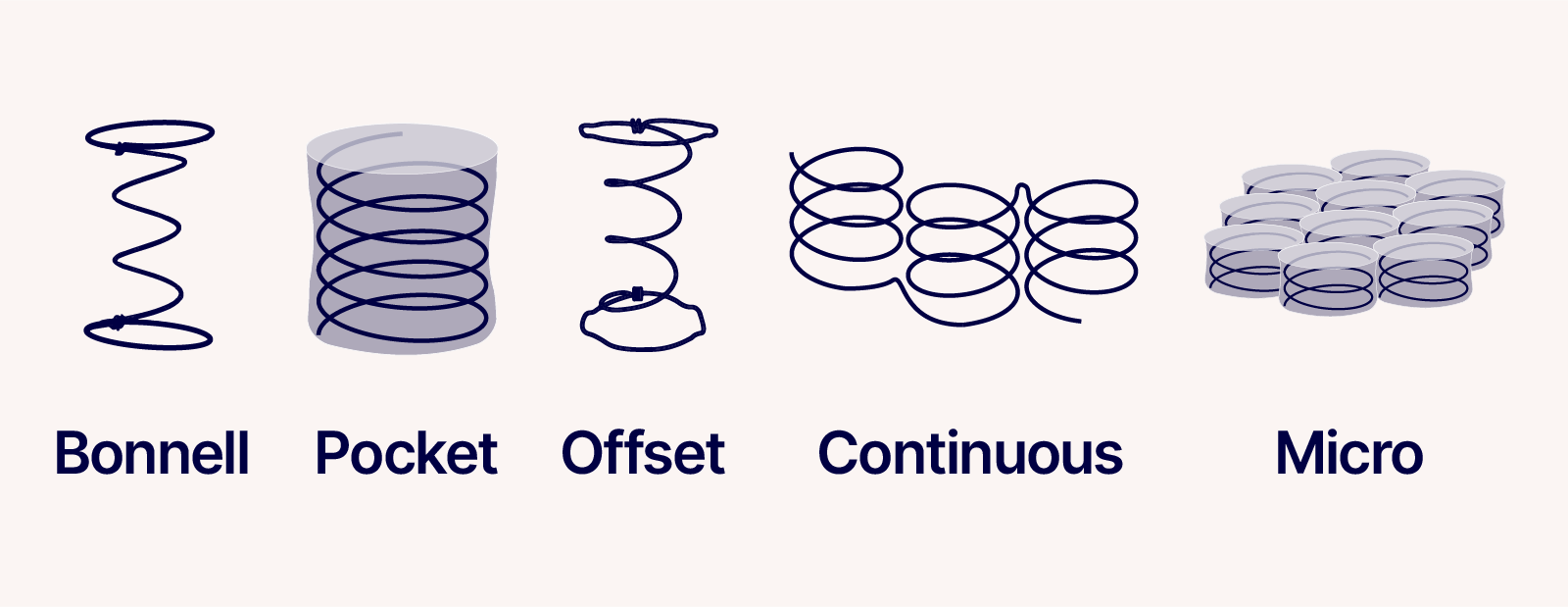Foam vs Hybrid Mattress: Which Mattress Type Should You Choose? (2025)
Updated: March 31, 2025 | Published: August 13, 2024When it comes to choosing a new mattress, the decision between a hybrid mattress vs memory foam can be daunting. Both offer unique benefits and cater to different sleep preferences.
Foam mattresses, constructed solely from foam layers, provide excellent motion isolation and pressure relief, making them ideal for light sleepers or those with body aches. On the other hand, hybrid mattresses combine foam layers with coil systems, offering a balance of support, breathability, and bounce.
In this article, we’ll delve into the characteristics of foam and hybrid mattresses, comparing their construction, pros, and cons to help you make an informed decision.
Breakdown: Hybrid vs Foam Mattress
| Category | Hybrid Mattresses | Foam Mattresses |
|---|---|---|
Cost | $1,000–3,000+ | $500–2,000+ |
Feel | Balanced feel with a higher level of bounce and responsiveness | Can contour around your body or allow you to lie on top, depending on foam density |
Advantages | Good balance between support, bounce, and breathability | Excellent motion isolation and pressure-point relief |
Disadvantages | Can be noisier due to the presence of inner coils
| Can trap heat, especially in mattresses with a softer feel
|
Best for… | Sleepers preferring more bounce and support as they sleep
| Light sleepers
|
READ MORE: Which mattress type is right for you?
Foam Mattresses
Foam mattresses like Douglas, Octave, and Juno offer several advantages, including better motion isolation and superior pressure-point relief compared to many hybrids. They also come in a wide range of foam types to suit different preferences.

READ MORE: What is the difference between foam vs spring mattresses?
Foam Mattress Materials
Foam mattresses typically feature multiple layers of foam, including memory foam, gel foam, poly foam, or latex foam.
- Poly foam typically offers excellent support and breathability. It can also have widely different firmness levels, depending on foam density. Poly foam can be less expensive to produce than other types of foam, so it’s often used in affordable mattresses.
- Memory foam adapts to different amounts of pressure and contours to the body’s shape, letting you sink into the mattress somewhat. This can create a “hugging” effect while you’re lying down. You may notice heat trapping in closed-cell memory foam, but open-cell foam (and advanced cooling features) help increase airflow.
- Gel foam is a variation of memory foam that uses gel to move heat away from your body while you sleep. The gel can be infused or layered on top of the foam, depending on the manufacturer. The result is usually a cooler sleep that allows you to still enjoy all the body-contouring benefits of memory foam.
- Latex foam, which can be natural or synthetic, provides a responsive feel and better temperature regulation than other types of foam due to its open cell structure. This type of foam is long-lasting and can be more expensive than other foams, but it’s often worth the investment.
READ MORE: Get our ranked list of the best memory foam mattresses
Some foam mattresses also include extra cooling features to prevent heat trapping and ensure a comfortable, more refreshing night’s sleep. For example, Octave Vista, our pick for best cooling mattress, comes with a cooling nanofibre cover to pull sweat away from your body, copper-infused memory foam treated with phase-change material for temperature balance that adapts to temperature fluctuations, and multi-zone support foam with breathable air channels for air circulation.
Foam Mattress Pros & Cons
| Pros | Cons |
|---|---|
|
|
Hybrid Mattresses
Hybrid mattresses like Logan & Cove combine foam comfort layers with coil support systems to offer a balanced sleep experience. They provide a balanced feel with a combination of foam contouring and coil support, paired with durable construction and enhanced breathability.

READ MORE: Hybrid mattress vs memory foam
Hybrid Mattress Materials
Hybrid mattresses use inner coils, often made of steel, combined with at least one layer of foam that’s at least 2″ thick. Often you’ll find several foam layers and multiple coil layers, especially in quality hybrids like Logan & Cove Frontier.
We have already explored different types of foam in this article, such as memory foam, latex foam, and poly foam. Let’s go over the different types of coils you might see in a hybrid mattress.
- Bonnell coils are shaped like an hourglass and typically wired together to form a single unit. They’re less durable, supportive, and motion-isolating than other coil types.
- Pocket coils are individually wrapped in fabric and operate independently, making them whisper-quiet and excellent at contouring to your body.
- Micro coils are similar to (and often paired with) pocket coils, but much smaller. This type of coil provides added contouring and responsiveness.
- Offset coils are interconnected like Bonnell coils but not as rounded, and they have better motion isolation and support.
- Continuous coils are rows of circular connected wires. They’re durable, but they don’t provide good motion isolation, are less comfortable to sleep on, and are fairly noisy.

Hybrid Mattress Pros & Cons
| Pros | Cons |
|---|---|
|
|
Should you choose a foam mattress vs hybrid mattress?
The choice between foam and hybrid mattresses depends on individual preferences, sleep habits, and budget considerations.
Choose a foam mattress if you’re looking for exceptional motion isolation and pressure relief. This type of mattress is especially good for light sleepers and people with chronic pain. Foam mattresses are often less expensive, too, which is great for mattress shoppers on a budget.
A hybrid mattress may be a better choice if you need a balance of support, breathability, and responsiveness. It’s also a good fit if you and your partner have different sleep preferences.
READ MORE: How to choose a mattress
Ultimately, consider your unique sleep needs and preferences when choosing between these two popular mattress types to ensure a restful night’s sleep.
Our goal is to provide the information you need to find the mattress that’s right for you. Get started with some of our most popular mattress shopping resources:
- Best Mattress Guides: Best Mattress Canada, Best Mattress In a Box
- Reviews: Douglas Original, Logan & Cove Choice, Juno, Octave Vista
- Comparisons: Douglas vs Endy, Douglas vs Casper
We use independent, third-party engineering firms (commissioned by us) with the APEGA stamp of approval to conduct mattress testing on our behalf, using publicly available data. We review and test all mattresses on 40+ criteria we think are important to you, including price, country of manufacture, sleep trial, warranty, features, materials used, motion isolation and edge support ratings, customer satisfaction reviews, returns, and refunds.
